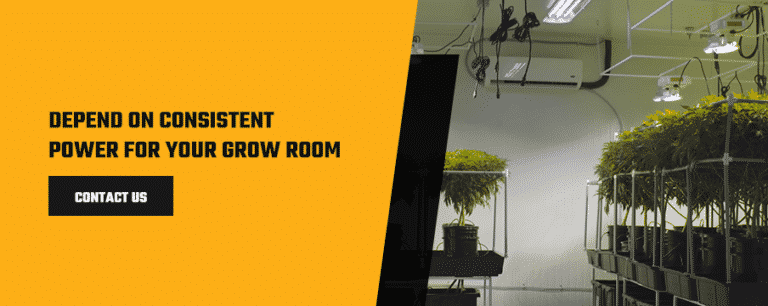Backup Power for Grow Rooms
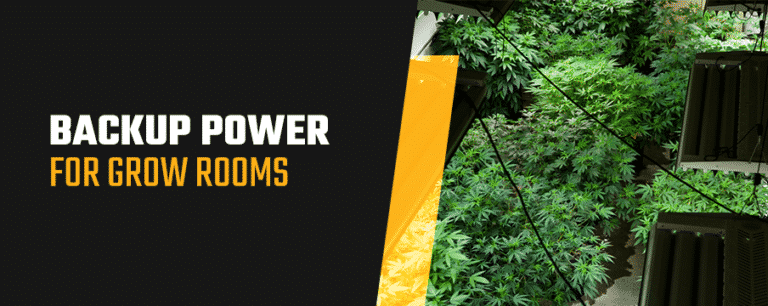
As of January 2019, the total number of U.S. states that have legalized medicinal marijuana is 33, plus Washington D.C. As the number continues to increase, the industry is relying more on backup power to generate their facilities. Professionally grown cannabis requires a delicate environment to thrive, so when power outages occur, how can you ensure that your crop can continue growing in optimal conditions?
Electricity is a commodity that is often taken for granted and the absence is noticed when we need it most. A surefire way to help backup your grow operations would be with a backup generator. As a grow room manager, it’s a smart idea to rely on a backup generator rather than waiting for power to be restored to the main power grid. Power outages to the primary power grid could last anywhere from several hours to a few days, depending on the severity of the outage. Properly preparing for a power outage with the right backup power system can help keep your operations up and running.
Why You Need Backup Power for Your Grow Room
Marijuana grow operations demand consistent, reliable power to generate perfect conditions. Whether you’re building a new facility from the ground up or upgrading your grow site, you need sufficient energy to support your operations, such as:
- Lights
- Pumps
- Thermometers
- Ventilation
- Fans
- Hydroponics
- Humidifiers
- CO2 Generators
- Irrigation systems
- Other electrical components
Adequate power will make for a smooth, productive, efficient and safe process. Hundreds of parts create a functioning grow room, so when you invest in a new or used standby generator, you can ensure to meet the precise requirements.
What Can Happen If You Don’t Have Backup Power?
Backup power can save your operations in various situations. If you don’t have backup power or enough energy to run your grow room, it can affect your entire system. Your lights, fans, hydroponics and other crucial equipment will lose power. You will also be unable to sustain the germination, growth or flowering of your marijuana plants.
While a loss of power for a few hours may not cause severe detriments, several days without the right resources can result in devastation. When your cannabis plants receive no light for extended periods, it can cause them to flower early, resulting in lower yields. Without a regulated and consistent environment, the plants will be out of sync.
A lack of electricity can affect everything from hydroponic systems that rely on feeding machines to large operations that rely on lighting timers. When a blackout happens, even your security system can shut down, leaving you vulnerable to theft and damage. If you move from one area to the next via swipe cards and digital keys, you may not be able to access certain sections.
When you invest in a reliable and efficient asset, you can support your company’s bottom line. You’ll have peace of mind that your operations can remain steadfast even during inclement weather or other adversities.
What to Look for in a Grow Room Generator
Similar to buying other heavy equipment, investing in a generator is specific to your applications, requirements, budget and environment. The best thing you can do is take each part of your grow room into consideration from the bottom up — from the vital to the non-vital components. You can also reach out to a dealer for guidance with a foundation in mind of what you need.
There are a few specifics to take into account. Ask yourself:
- How much power do I need?
- What’s my budget?
- What protection features are available?
- What are my state’s laws and regulations?
- Will the generator fit in my location site?
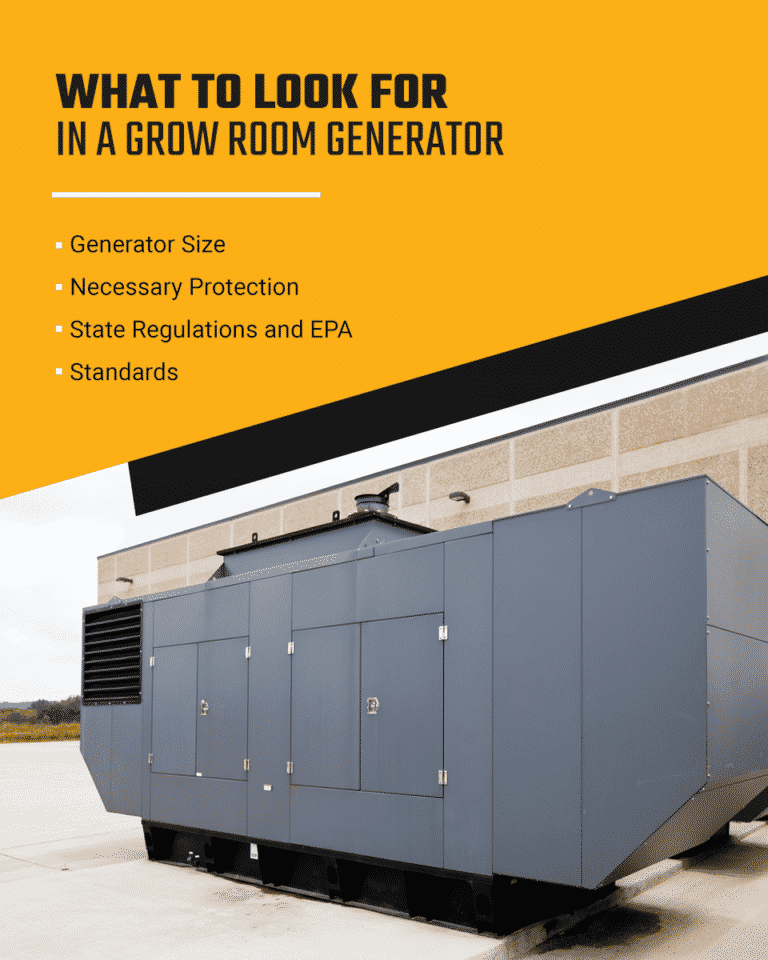
Before you invest in a used generator, you will need to take several measurements and calculations. You will also want to research your state’s regulations and the Environmental Protection Agency’s standards. If you’re unable to make the calculations yourself, you can always rely on the experts. When considering which type of grow room generator to use, consider:
Generator Size
Knowing the size of your backup generator is critical if you want to sustain your marijuana grow room. The unit’s size relates to how much power it produces, as well as your budget. The more kilowatts you need, the higher the price.
Start by calculating your total power requirements. You will want to consider the power output ratings for all your systems. Making a list of the gear you have — fans, pumps, lamps and more — can be a helpful first step. Then, figure out the starting and running wattage of all your items and combine them for a total power requirement.
You also want to think about the future growth of your operations. Are you looking to expand? Will you be adding new lights or switching to a different nutrient system? If you’re looking to increase your business, you should invest in a standby source that delivers at least 10 percent additional power. In other words, invest in a unit that provides 10 percent more of the total energy you need. However, if you’re not looking to upgrade, choose a generator that suits your current grow room.
When you understand how much power output your operations entails, it helps you determine what size solution you need. The right size will ensure your grow room operates without issues. A unit that’s too small compared to the amount of power you require will work harder than what it can withstand, shortening its lifespan. An oversized generator can cost you more money. If you choose the right asset, you can allocate your resources and money to other aspects.
Your cannabis grow room necessitates a strong enough power supply to support the foundation of all its procedures, so always be sure to consult with an expert to verify if the generator you’re looking to purchase can support your operational requirements.
Necessary Protection
Although generators can withstand a multitude of environments and conditions, you should consider an extra layer of protection. Your unit may need more rugged shielding to endure various situations, especially if you live in cold-weather regions. Consider a weatherproof enclosure to keep the system safe from the elements and protect it from work site incidents.
You also want to ensure your power source has advanced safety features like an emergency stop and an oil pressure meter. Other features to look into include temperature monitoring and protected circuit breakers. With the right external and internal protective components, your generator can better aid you as a secondary source of power.
Depending on where your grow operations are taking place, you may need to protect the workers and locals in the surrounding area. Commercial generators produce a lot of noise and can reach high decibel ratings that can damage eardrums, resulting in hearing loss or damage. There may also be local noise ordinances set in place within your town or municipality that needs to be strictly adhered to. In order to combat this, a sound-attenuated enclosure could be a great solution. Sound-attenuated enclosures not only provide weatherproofing to help protect your generator from the elements, but also provide sound dampening components to reduce noise.
State Regulations and EPA Standards
With any operation, it’s crucial to research state and local laws regarding your standby unit. Make sure you abide by the regulations and even consider EPA standards, zoning requirements and land laws. The EPA often upholds strict emission standards concerning diesel-powered engines.
If your site is located in a more urban area, zoning requirements may be more stringent compared to those in a rural setting.
When you have an idea of your power and protection requirements, along with generator regulations, it will be easier to determine what commercial generator you require. If you’re not sure how to calculate your power needs, our techs can help. You can also ask a professional to size your current output. Technicians will be aware of state, local and EPA laws as well.
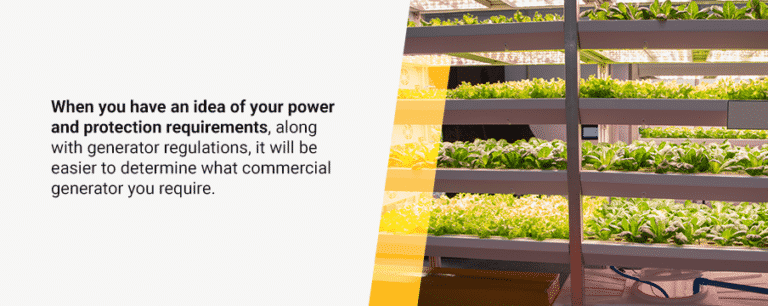
Because marijuana plants demand precise conditions when it comes to light, moisture, air, heat and other elements, the right generator will produce consistent energy without fail.
Types of Commercial Generators
Your emergency power source may need to provide continuous energy for several hours or days. Areas prone to power outages or places that experience harsh winter conditions can rely on generators for up to several weeks. Even if you are further from the main power grid, it can affect your reliance on consistent electricity.
According to the Energy Information Administration, most facilities experience one or two outages annually. No matter the severity of the issue, investing in backup power can save your grow room operations. But what type best suits your particular needs?
There are many sub-categories to consider when determining which type of commercial generator is ideal for your application, such as:
New vs. Used
The first step is to determine whether you want a new or used commercial generator. If you partner with a reliable dealer, a used unit can reap the same benefits as a new one — but without the high upfront cost and fast depreciation. A reputable dealer will also maintain and test their used equipment to ensure it is running at the highest standards.
If you choose the right partner, you can gain access to reliable generators at a lower cost while gaining efficient solutions.
Fuel Types
There are many different types of fuel that generators can use, but the most common for commercial generators include:
- Diesel: Diesel is the most common fuel type. Although it’s a reliable source, it emits higher emission levels than others — which is where EPA standards come into play. Diesel standbys require less overall maintenance and deliver fast kick-in times for critical operations. You can also store diesel onsite.
- Natural gas: Natural gas generators are quieter than diesel and more eco-friendly by burning cleaner. Although they require more maintenance, they are often viewed less expensive to run, as natural gas is considered a cheaper fuel source when compared to diesel. However, you cannot store natural gas onsite, and they may not produce as fast startups as diesel.
- Bi-fuel: Bi-fuel is a combination of diesel and natural gas that’s better at meeting EPA standards, although it’s not a typical option for generator units.
- Propane: Propane fuel is ideal for remote grow room sites. It’s a great option when other solutions aren’t available.
Three vs. Single-Phase Generators
The difference between a single and a three-phase generator is how they provide power. Three-phase standby units produce three separate waves of power that work in sequence. The flow forms consistent energy, making it more powerful for commercial and industrial purposes. Three-phase machines are often 480 volts with 12 connectable and re-connectable cables. Their reliability is unparalleled for grow rooms of any size.
A single-phase produces one alternating voltage, creating varying levels throughout the unit’s cycle. The waves result in dropped power levels. Single-phase generators are ideal for residential and other smaller operations or for equipment that has a lower power demand.
Standby vs. Prime vs. Portable Units
Standby generators are an integral part of marijuana grow rooms because they provide power at the exact moment you need it. If paired together with an automatic transfer switch (ATS), a standby unit operates automatically, giving you immediate electricity. The automatic transfer switch moves power from the main grid to your generator and monitors the utility power.
You can rely on technicians to install your standby, along with its wiring and switchboard. They can also help you adhere to codes and regulations.
Prime generators are generators that act as a primary power source. If your operations are located off-site and away from the main power grid or to help with peak shaving, then a prime generator can help keep key systems & equipment running.
While a portable generator delivers power when you need it, it can be less convenient for cannabis grow rooms. When a blackout occurs, you need power right away.
How to Maintain a Grow Room Generator
Maintenance is the key factor in increasing the lifespan of your unit and upholding consistent levels of power. The first step is to refer to the manufacturer’s manual. Different makes and models of backup generators will require different maintenance. Your handbook will indicate the appropriate routine upkeep schedule for your power system.
Your schedule can include daily, weekly and monthly tips, as well as annual and bi-annual maintenance requirements. For example, you will need to conduct oil assessments and fluid top-ups, as well as check the hoses, belts, battery terminals, cables, and other parts.
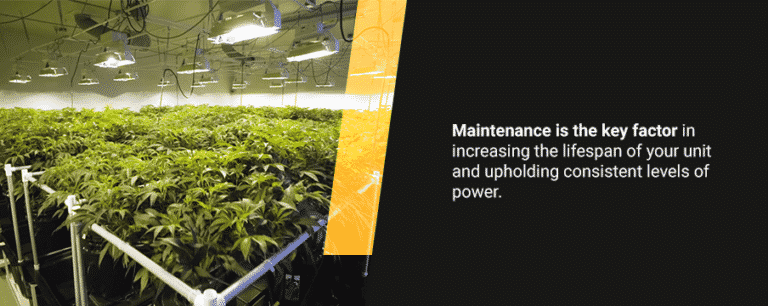
Generator maintenance also depends on the frequency of use. If you find yourself using your generator often, then the maintenance schedule will need to be adjusted accordingly to ensure that inspections & maintenance intervals are kept regularly.
Without proper and consistent upkeep, you can put your grow room, yourself, and your employees at risk.
In order to ensure that your generator is in tip-top shape, work with a professional generator technician to work out a schedule for you and consider forming a service contract for the technician to perform the scheduled routine service & maintenance.
Daily and Weekly Checks
If you use your generator as a primary power source, conduct walk-around inspections each day. As you’re inspecting the unit, search for severe damage. Make sure no alarms set off and operations are efficient.
Many grow rooms and other industries rely on generators for backup power in emergencies. If you need a generator only in specific instances, daily inspection is not necessary.
Depending on your situation, weekly checks may be appropriate. Top-up fuel levels, check for leaks and look for corrosion.
Monthly, Bi-Annual and Yearly Inspections
Each month, examine the coolant fluid and engine oil levels. During the beginning of each year, you should also schedule a maintenance check with a professional technician. Other upkeep tasks include oil changes, replacing filters, swapping out spark plugs and ensuring the battery has a sufficient charge. The mechanic should look for cracked hoses, drive belts and other crucial components.
Learn more about proper generator maintenance by referencing our checklist. After each inspection, make sure you keep a record. It should include the time, date and person who conducted the maintenance. The record book should also include any tests and repairs that were done for future reference.
Depend on Consistent Power for Your Grow Room
Woodstock Power partners with you to determine the best power solution for your marijuana grow groom. We work hard to find a generator that matches your application, requirements and budget. Our experts assist you with turnkey services nationwide, including installation support. We can handle any size project while delivering tested generators with no lead times.
Explore our grow room generators or contact our support team for more information. Woodstock Power grows with you as your needs change while maintaining transparency to help ensure you receive top-tier assistance.


